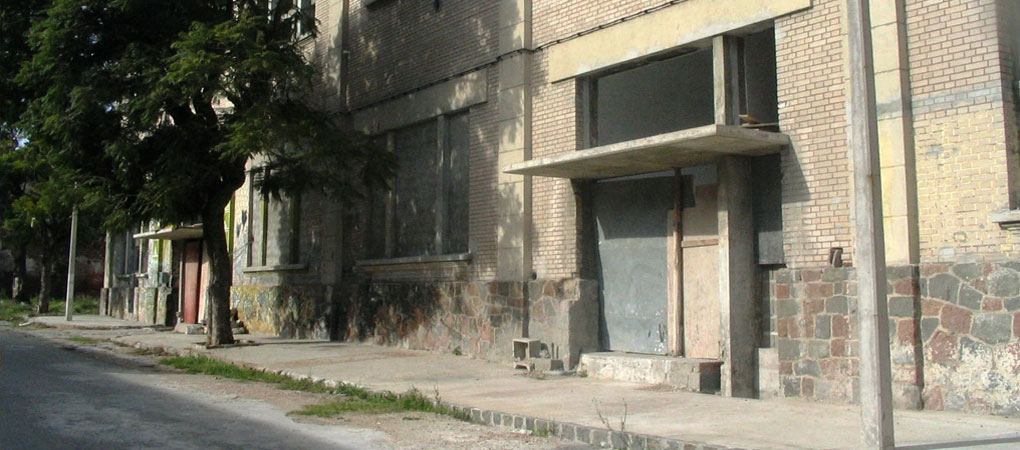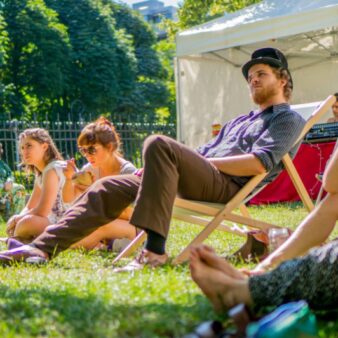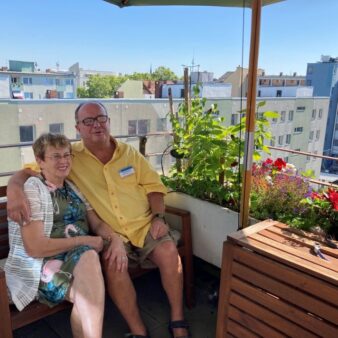This mutual help housing project involves the conversion of a derelict building in central Montevideo into 36 apartments by a cooperative of Afro-Uruguayan women-headed households. Initiated by the local community-based organisation Mundo Afro, this innovative project addresses the issue of derelict buildings in central areas of the city, allows for the incremental improvement of flats and promotes social integration as well as racial and gender equality.
Project Description
Aims and Objectives
- To provide affordable housing for low-income women-headed households through a mutual-help cooperative approach.
- To contribute toward the improvement of living conditions of the Afro-Uruguayan population in Montevideo and rehabilitate an area that is meaningful to this community.
- To avoid the further gentrification of the Barrio Sur neighbourhood and contribute toward the physical recovery of central areas of the city, making better use of existing stock and infrastructure.
The Afro-Uruguayan population descends from slaves brought over from Western Africa during colonial times. Once slavery was abolished, families settled in the Barrio Sur neighbourhood of Montevideo in collective houses named ‘Conventillos’. Approximately six per cent of the Uruguayan population belongs to this group. Their social and economic conditions are poor – most work as labourers and have low levels of education. Forty per cent of Afro-Uruguayan women work as domestic staff. Under the dictatorship of the 1970s, several Conventillos were demolished and many residents were forced to move to the outskirts of the city. Housing projects for white middle-class families began a gentrification process in the area. The community is trying to get back to the neighbourhood but is struggling with lack of resources and public support. Barrio Sur is located in the central area of Montevideo, a city that has experienced depopulation in recent years and is characterised by an increasing number of empty properties. This project provides housing for Afro-Uruguayan families through the adaptive re-use of a derelict building.
The main group benefiting from the project is the UFAMA al Sur housing cooperative, with 36 low-income families, the majority of which consist of Afro-Uruguayan female-headed households. The project is being carried out in the Barrio Sur neighbourhood of Montevideo, where the community has strong historical ties.
This mutual help housing project involves the conversion of a derelict building in central Montevideo into 36 apartments for low-income families. This innovative project addresses the issue of derelict buildings in central areas of the city, allows for the incremental improvement of flats and promotes social integration as well as racial and gender equality.
The project was initiated in 1998 by Mundo Afro, a local community-based organisation that works to empower the socially excluded black minority in Uruguay. To address the housing needs of its members, the organisation formed the UFAMA al Sur housing cooperative and contacted the Uruguayan NGO Ciudad y Región, who would provide technical assistance to the group. Together the organisations designed a participatory housing programme based on the principles of mutual help and self-management of resources.
An abandoned warehouse building was sold to the cooperative by the Municipality at a subsidised rate. Residents contributed with their labour and funding was provided by the Ministry of Housing in the form of housing subsidy. A percentage of this subsidy is to be repaid over a five-year period, after which ownership will be transferred to each family. Through a process of mutual-aid and self-management, the cooperative was able to provide thirty-six 60 m2 units at the same cost as the standard social housing carried out in the outskirts of the city, which had an average area of only 32m2 per unit. The project also includes communal gathering spaces, playgrounds, sports facilities and a garden roof. Each flat can be improved and the layout modified to adapt to particular family needs through the addition and/or reconfiguration of internal subdivisions.
The project is valued at US$611,360, or US$16,982 per unit. This includes the following:
- US$353,163 in construction costs (materials, labour and taxes).
- US$34,930 in professional services and advice.
- US$136,600 market value of the building which was sold to the cooperative by the Municipality at a symbolic rate of US$6,450. The US$130,150 difference was considered subsidy.
- The residents contributed with their own labour, worth approximately US$86,665.
Funding has been provided by the Ministry of Housing in the form of subsidy at a rate of US$11,800 per family, which comes to a total of US$424,800. The project is currently funded by the Ministry of Housing. The British Embassy has also supported the programme through the provision of machines for construction, tiles and sanitary-ware for toilets and kitchens.
The project involves a self-management approach where residents are at the forefront of the planning, design and management processes. Institutional support and technical assistance have been provided by Ciudad y Región as well as Mundo Afro. The UFAMA al Sur Cooperative, under the supervision of Mundo Afro, is responsible for the management not only of the housing but also of the building’s sports facilities and community centre.
The project began in 1998. Following delays and long waiting periods due to bureaucracy and other external factors, the building works are nearing completion.
Why is it innovative?
- Adaptive re-use of a derelict building in central Montevideo.
- This is the first housing project that has emerged from within the Afro-Uruguayan organisations and is the first housing project in the area in which spatial, identity, racial and gender aspects have been taken into account.
- Partnerships were created among community-based organizations, NGOs, local and national governments. Residents played a leading role throughout all stages of the process.
- The project allows for the incremental improvement of flats through the addition and/or reconfiguration of internal subdivisions and explores the possibilities of low-rise, high-density projects in central urban areas.
- Funding for the project involves a creative combination of existing government funding mechanisms.
What is the environmental impact?
The project involves the adaptive re-use of a derelict building in the centre of Montevideo in Uruguay, making use of an existing physical asset and urban infrastructure.
The building has been designed with an energy conservation scheme, with special attention given to natural daylight and ventilation, high insulation and individual, natural gas-powered heating and hot water boilers.
The project is based upon a compact-city approach, where social diversity and mixed-use is understood as a sustainable urban form in terms of energy saving in transport and a richer social environment. The redevelopment of brownfield sites and disused buildings are in line with this concept.
Is it financially sustainable?
The project is funded by a combination of existing government funding mechanisms. Whilst the political situation may change, it is unlikely that funding for the national subsidy programme and the Municipal urban renewal programme will cease in the near future.
The mutual-aid process has strengthened the links amongst the future residents of the building and has generated income opportunities for some members, or relatives of members, as hired staff for the construction work. Training in construction and management has been provided by Ciudad y Región and has also been helpful in income-generation strategies for the cooperative members.
Families repay a portion of the government subsidy at a rate of US$20 per month for five years. It is a symbolic repayment established by the national housing subsidy programme. The monthly income of all families in the cooperatives is under US$300 and renting a similar flat in the area costs approximately US$110 per month.
After the five-year repayment period, ownership of the apartments is transferred to each individual family. Should they choose to sell the property within the first 15 years of occupation, a portion of the original housing subsidy must be returned. The exact amount is calculated based upon the amount of time they have lived in the property (taking into account the value of their labour in the mutual help construction process and the repayments over the first five years).
What is the social impact?
The social reinsertion of the group in their former (now gentrified) neighbourhood of Barrio Sur, where a new population of different cultural background and income had settled, was not easy. During the construction process, the sharing of common areas, including the existing playground and sports facilities, by incoming residents and the existing population helped to make the process easier. The conception of the building based on the Conventillos, as a space for shared activities and gathering, promotes cohesion amongst the member families of UFAMA al Sur. Additional neighbourhood facilities (sports facilities and a community centre) will be shared with the wider community upon completion and used as a device to further integration.
NGO involvement with the group of residents has been very important in the training process and in the capacity building of the group (both the cooperative and the professionals) to develop the skills needed for this kind of conversion. The project was designed to fit with different kinds and levels of work, some for unskilled labour that could be carried out by the women. Mutual-aid work was combined with the participation of contractors at several stages in order to optimise the final result.
One of the main objectives of the programme is to empower Afro-Uruguayan individuals and families and improve the physical, social and economic conditions of a minority group that has traditionally been excluded from society. The project actively works toward the reduction of gender, racial and social inequalities. Members of the cooperative have increasingly taken part in gender, racial or social integration forums and events.
Barriers
The programme had political support from many different actors and institutions. However, it was close to failure due to the hostility of the neighbours based on prejudices and misunderstandings, believing that the project would go against their interests. Long discussions and negotiations have overcome the problem, but it is a continuous, daily process of relationship building.
For a number of reasons, the process has become extremely long, leading to additional costs and strained relationships. This is largely due to external conditions such as stalls in the funding process, financial crises in the country, political changes, etc. Greater institutional involvement would shorten times and avoid interruptions once the work begins.
Lessons Learned
- The potential of civil society initiatives – this project makes the most of the existing institutional framework, coordinating the efforts of institutions that do not have a tradition of collaboration. This has been possible due to the initiative and negotiating skills of the housing cooperative.
- Programmes with a specific racial or gender approach can lead to friction – from the outset the project was designed for Afro-Uruguayan women-headed households, though open to diversity to avoid creating a ghetto. Every time a new family was about to enter the cooperative, the issue of whether or not to include families that didn’t fulfil these criteria was raised for discussion. This has somewhat hindered the flow of the project.
- The advantages of shared work and the involvement of NGOs from inception – the negotiation process as well as the project development would not have been possible without the close collaboration and mutual exchange between the cooperative and the NGO. To achieve this collaborative environment it is necessary to develop a common language and mutual trust.
- Technical advice should have differentiated standard professional fees for urban redevelopment or adaptive re-use as opposed to greenfield developments, to encourage NGOs to accept the challenges involved by the former. Negotiation and construction times should be shorter in order to make it easier for more groups to try this approach, making the most of the built environment.
Evaluation
The project has been studied by the Ministry of Housing as a precedent for specific credit lines in the future Five-year Housing Plan and some members of the cooperative have been invited to participate in its Advisory Group.
Whilst no formal independent monitoring or evaluation study has been carried out as yet, the Ciudad y Región organisation has closely monitored the progress of the project and the work of the UFAMA al Sur cooperative.
Transfer
This is the first project of its kind carried out by the submitting organisation. The experience has been widely shared among national and Latin-American cooperative networks. Further transfer of the project may be possible if institutional support can be formalised, creating specific programmes for funding and access to land.
Other minority groups within the Mundo Afro organisation are working to establish similar projects in Montevideo as well as in Rivera and Durazno, other Uruguayan cities with an important Afro-Uruguayan population.
There is a strong tradition of cooperative housing in Uruguay and this demonstration project is encouraging a more sustainable use of the available housing stock and abandoned commercial buildings in urban areas within the nationwide cooperative movement, as well as within local and national governments.
Partnership
CBO



